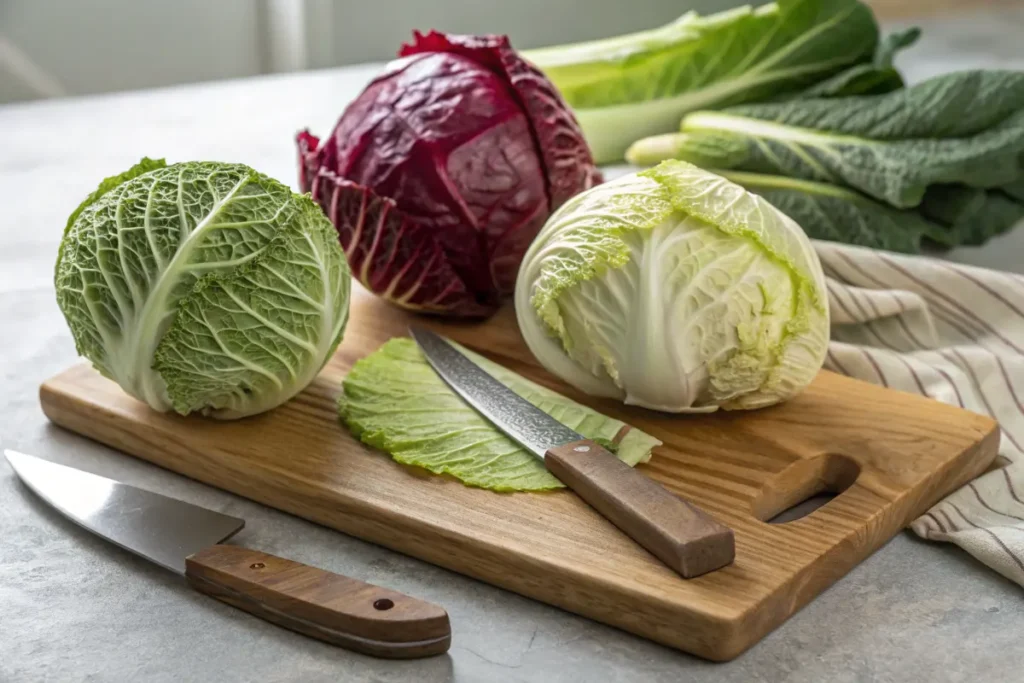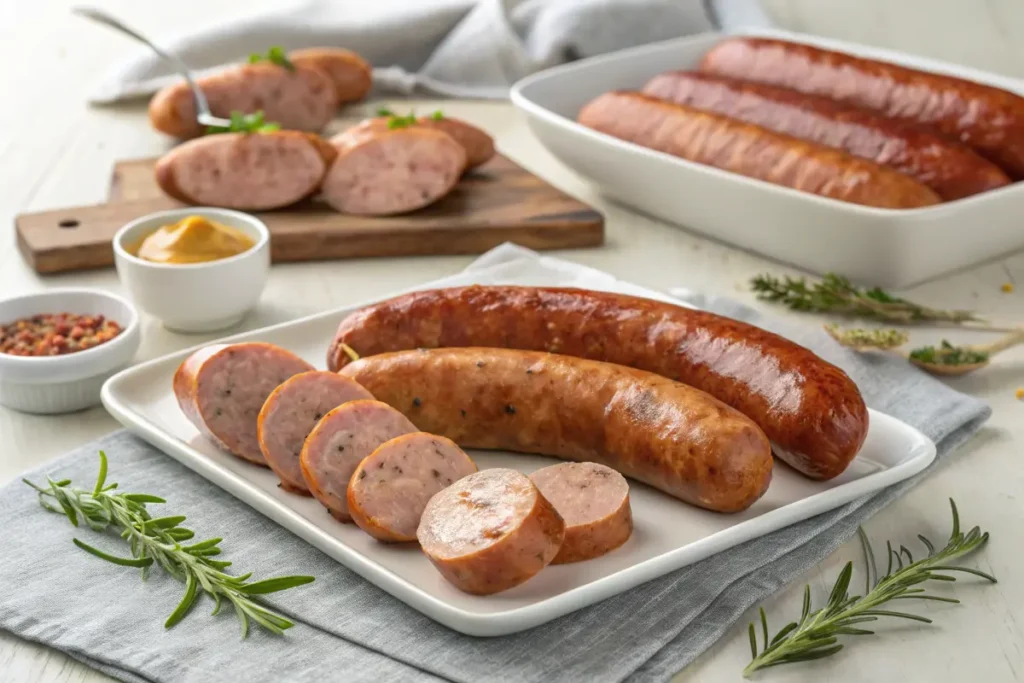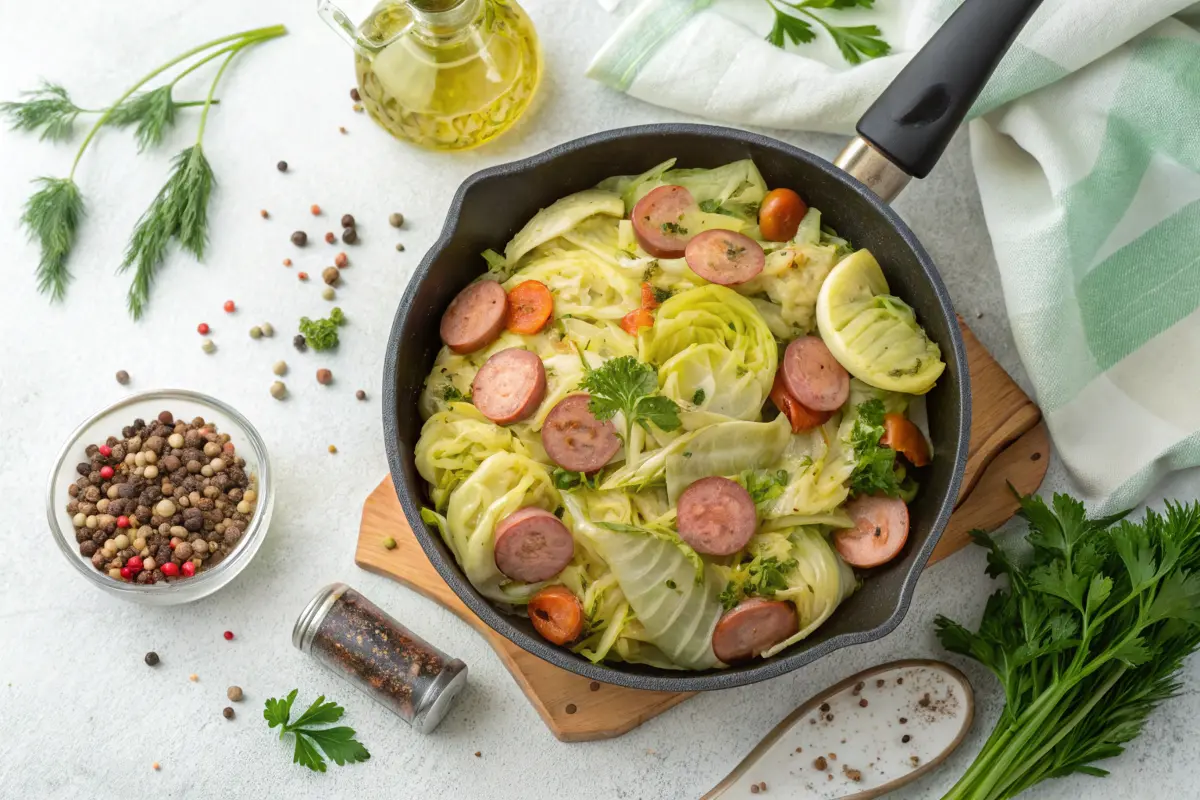Figuring out what’s in our food can be a real head-scratcher these days, especially when you’re keeping an eye on carbs. Cabbage and sausage—a classic combo enjoyed in many ways—are no exception! Whether you’re diving into a low-carb diet or just curious about your meal’s nutritional profile, understanding the carb content of what you eat is key. This article will be your go-to guide, unraveling the mystery of how many carbs are in cabbage and sausage. We’ll explore different types of both, break down the numbers, and even offer some tips to help you make informed choices. So, let’s jump right in and get the lowdown on this comfort food staple!
1: Introduction to Cabbage, Sausage, and Carb Counting
The Popularity of Cabbage and Sausage Dishes
Cabbage and sausage—it’s a pairing that’s popped up in kitchens across the globe for ages! From hearty stews in Eastern Europe to cozy casseroles in the US, this combo is beloved for its simple flavors and satisfying nature. There’s something about the slight sweetness of cabbage complementing the savory sausage that just hits the spot. Moreover, it’s a dish that’s relatively easy to make, often with variations passed down through families, which means you might find it on menus both in your local deli and at a fancy restaurant. It’s no surprise, then, that this pairing is a popular choice in many households.
Why Track Carbohydrates?
Now, why bother tracking carbohydrates in the first place? Well, for many, it’s all about managing health goals. Folks keeping an eye on blood sugar levels, or trying to lose or maintain weight often pay close attention to their carb intake. Carbohydrates are a major energy source for our bodies, but when we eat too many, they can be stored as fat, hence the focus of many on regulating their carb intake. Plus, understanding how many carbs are in cabbage and sausage, or any meal really, can help you make more mindful choices when you’re deciding what to eat for your next meal.
Brief Overview of the Article’s Focus: Carb Counts in Cabbage and Sausage
2: Understanding Carbohydrates in Food
This article aims to give you a thorough understanding of the carb counts in both cabbage and sausage. We’re going beyond just stating numbers! We’ll look at different types of cabbage, like green cabbage, red cabbage, and savoy cabbage. We’ll also delve into various kinds of sausage, from Italian sausage to Polish sausage, helping you see how those variations impact the overall carb content of your meal. By the end of this read, you’ll be able to confidently answer the question of how many carbs are in cabbage and sausage and make great choices about your dietary needs. Additionally, we’ll touch on how to put it all together for a low carb recipe and discuss some of the health benefits associated with this classic combo.
What are Carbohydrates?
Alright, let’s dive into what carbohydrates actually are. Simply put, they are one of the three main macronutrients—along with proteins and fats—that our bodies need to function. Think of carbs as the primary fuel source that gives us the energy to get through the day. They’re found in a huge range of foods, from fruits and veggies to grains and, yes, even in some of our favorite dishes like cabbage and sausage. Carbs are essentially sugars, and our body breaks them down to use them for energy, and this is why it’s so important to understand what carbohydrates are in your food.
Types of Carbohydrates: Simple vs. Complex
Now, not all carbs are created equal. There are two main types: simple carbohydrates and complex carbohydrates. Simple carbs are quickly digested and provide a quick burst of energy. These are the types you find in sugary drinks and candy. On the other hand, complex carbohydrates are digested more slowly, providing a more steady source of energy. These types of carbs are found in whole grains, vegetables, and beans. Consequently, the type of carbs we eat can have a big impact on our energy levels and overall health, and knowing the difference is crucial when considering how many carbs are in cabbage and sausage.
How Carbohydrates Affect Your Body
So, how exactly do carbohydrates affect your body? As we touched on earlier, they are our body’s go-to fuel source. When you eat carbs, your body breaks them down into glucose, which then enters your bloodstream. This glucose is used for energy by our cells. However, if your body doesn’t need all that energy right away, some of the glucose is stored as glycogen in the liver and muscles, and the rest can be converted into fat. Therefore, understanding the different types of carbs and how many carbs are in cabbage and sausage is key if you’re trying to manage your weight or blood sugar levels.
The Importance of Fiber in Carbohydrates
Lastly, let’s talk about fiber, a special kind of carbohydrate that our bodies cannot digest. Fiber is super important for our health because it helps with digestion, promotes feeling full, and can even help with managing cholesterol levels. Moreover, you’ll find fiber in many plant-based foods, including cabbage. So, when we’re talking about the carb content in foods, we must also consider the fiber content because fiber is a part of the total carbohydrate count but doesn’t have the same impact on blood sugar.
3: Carbohydrate Content of Different Types of Cabbage

General Carb Information for Cabbage
Cabbage, a staple in many cuisines, is surprisingly low in carbs. Generally speaking, most types of raw cabbage contain about 5-7 grams of total carbohydrates per 100 grams. But before we dive deeper, remember that fiber is a significant portion of those carbs. This means the net carb count of cabbage, which is the total carbs minus the fiber, is even lower! Now, while we know how many carbs are in cabbage generally, let’s look into specific types.
Green Cabbage: Carb Counts and Nutritional Profile
Green cabbage, the most common variety, is a fantastic low-carb option. A 100-gram serving of raw green cabbage typically contains around 5 grams of total carbs, with about 2-3 grams of that being fiber. Furthermore, green cabbage is a good source of vitamin K, vitamin C, and other essential nutrients. Therefore, adding green cabbage to your meals is not only a great way to keep carb intake in check but also to boost your nutrient intake.
Red Cabbage: Carbohydrates, Fiber, and Benefits
Next up, we have red cabbage, with its vibrant color and slightly peppery flavor. Red cabbage has a very similar carb profile to green cabbage. You’ll find about 6-7 grams of total carbs per 100 grams of raw red cabbage, with a solid chunk of that being fiber. Red cabbage is particularly known for its high antioxidant content, and it is a nutritional powerhouse. Therefore, if you’re seeking variety, red cabbage is a stellar low-carb addition to your plate.
Savoy Cabbage: Analyzing Its Carb and Fiber Composition
Then there’s Savoy cabbage, with its crinkly leaves and mild flavor. This variety sits very close to its cousins when it comes to carbohydrates. Expect about 5-6 grams of total carbs per 100 grams of savoy cabbage, and it comes packed with fiber too. Its texture and mild taste make it super versatile in cooking, and you should definitely consider it when you are thinking of how many carbs are in cabbage and sausage.
Napa Cabbage: A Low-Carb Option Comparison
Finally, let’s look at napa cabbage, also known as Chinese cabbage. Napa cabbage is often praised for its lighter flavor and is frequently used in Asian dishes. In terms of carbs, napa cabbage is one of the lowest, with around 2-3 grams of total carbs per 100 grams. It’s a good choice for those on low-carb diets because its also high in water content and fiber.
Impact of Cooking Methods on Cabbage Carbs
It’s worth noting that cooking methods can slightly affect the carb content of cabbage. Boiling cabbage might cause some carbs to leach into the water. However, the change is usually minimal. Regardless of whether you steam, stir-fry, or bake your cabbage, it will still remain a low-carb choice. Therefore, when planning how many carbs are in cabbage and sausage, choose your preparation method based on taste preferences.
4: Carbohydrate Content of Different Types of Sausage

The Wide Variety of Sausage: A Brief Overview
Sausage, oh boy, it’s a world of its own! From the spicy kick of chorizo to the savory goodness of bratwurst, there are seemingly endless varieties. Each type not only has its unique flavor but also its own nutritional makeup. Therefore, when we’re talking about how many carbs are in cabbage and sausage, it’s essential to understand that different sausages bring different carb contents to the table.
Carb Counts in Italian Sausage
Italian sausage, a popular choice, usually has a moderate amount of carbohydrates. A typical 100-gram serving of Italian sausage might contain about 2-5 grams of carbs. However, it’s important to note that the carb content can vary depending on the specific recipe. For instance, if breadcrumbs or other fillers are used, the carb count will likely be higher. Therefore, it’s a good idea to always check the nutrition label, or look for more natural variations, when planning your meal.
How Many Carbs Are In Polish Sausage?
Let’s talk about Polish sausage, also known as kielbasa. This hearty sausage generally has a slightly higher carb count than Italian sausage, usually landing somewhere around 4-7 grams of carbs per 100 grams. Just like with Italian sausage, the use of fillers and binding agents in the Polish sausage can also have a direct impact on the carb amount. Therefore, when you are wondering, how many carbs are in cabbage and sausage, the type of sausage used is a crucial factor.
German Sausage Carb Analysis
German sausage, such as bratwurst, also has a range of carb counts depending on its preparation methods and ingredients. You might find bratwurst ranging anywhere from 3 to 8 grams of carbs per 100 grams. Many traditional German sausages are made with simple ingredients, but sometimes you’ll also find added carbs in the form of flour or breadcrumbs. Consequently, when you pair German sausage with cabbage, knowing these numbers is very important.
Breakfast Sausage Carb Content
Breakfast sausage, a staple in many morning meals, tends to have the lowest amount of carbs compared to the other types we’ve mentioned. Typically, it will contain 1 to 3 grams of carbs per 100 grams, especially if you choose the more natural kinds. However, it is crucial to read labels and choose products with minimal fillers, as these could dramatically change the carb count.
Impact of Fillers and Additives on Sausage Carbs
Finally, it’s essential to highlight that fillers and additives in sausage can significantly affect the carb content. Many commercial sausages use breadcrumbs, starches, or sugars as binding agents, which can all greatly increase the number of carbs. Therefore, when assessing how many carbs are in cabbage and sausage, it’s not just about the sausage type; it’s also about the ingredients used in it. Opt for sausages with minimal additives and fillers to keep the carb count lower.
5: How to Calculate Total Carbs in a Cabbage and Sausage Dish
Estimating the Portion Sizes of Cabbage and Sausage
Alright, so you’ve got your cabbage and your sausage and you’re ready to make a meal. But, how many carbs will it have? The first step is to estimate the portion sizes. How much cabbage are you using? And how much sausage? A good place to start is by using a kitchen scale or measuring cups. Visual estimations can also help, but be aware that our eyes can sometimes deceive us.
Using Nutrition Labels to Estimate Carb Count
Next, it’s time to use nutrition labels. Check the label on your sausage package to see the carbohydrate content per serving size, or per 100 grams. If you buy fresh produce, a quick online search can give you the carb content of the raw cabbage you’re using. This will allow you to get a more accurate estimate of how many carbs are in cabbage and sausage, before making the meal.
Calculating the Total Carbs in Your Recipe
Now, let’s do some math! Once you have the carb count for both the cabbage and the sausage, multiply it by the number of grams of each you’re actually using. For example, if 100 grams of cabbage contains 5 grams of carbs, and you’re using 200 grams, you’ve got 10 grams of carbs from your cabbage. Similarly, calculate the total grams of carbs from your sausage. Add these numbers together, and you’ll get the total number of carbs in your dish.
Accounting for Other Ingredients
Lastly, don’t forget about other ingredients. If you’re adding things like onions, garlic, oil, or any sauces, these ingredients also contribute to the total carb count. Though in many cases they will not be a considerable amount. Make sure to note each ingredient and calculate or estimate their contribution to the total carbohydrate content of your meal. Now, you have a better idea of how to figure out how many carbs are in cabbage and sausage, and are better equipped to enjoy your meal mindfully!
6: Low-Carb Recipes and Serving Suggestions with Cabbage and Sausage
Low-Carb Cooking Tips for Cabbage and Sausage
Alright, let’s talk about how you can make some delicious, low-carb dishes using cabbage and sausage. First off, remember that simple is often best. Moreover, when cooking with cabbage, avoid adding too much sugar or flour to any sauces or dressings, as this can quickly increase the carb count. Instead, focus on fresh herbs and spices to add flavor. Also, when choosing sausage, pick varieties with minimal fillers or added sugars. By following these tips, you can keep your meal low in carbs and high in flavor.
Cabbage and Sausage Recipes
Now, let’s get into some actual recipes! Here are a few options that are both tasty and low in carbs, that will help you answer the question how many carbs are in cabbage and sausage, by allowing you to control them.
Simple Skillet Cabbage and Sausage Recipe
This is an easy recipe for a busy weeknight. Simply sauté your sliced sausage in a skillet with a bit of olive oil. Once it’s browned, add shredded cabbage and some garlic, and cook until the cabbage is tender. Season with salt, pepper, and perhaps a dash of paprika. It’s a quick, delicious, and low-carb meal!
Baked Cabbage and Sausage Casserole
If you prefer a casserole, try this baked option. Layer shredded cabbage and sliced sausage in a baking dish, and pour over a mixture of eggs, cream, and your favorite herbs and spices. Bake until golden brown, and you have a hearty, comforting, low-carb meal.
Stuffed Cabbage Rolls (Low Carb Friendly)
For a slightly more complex option, consider stuffed cabbage rolls. Blanch cabbage leaves, and then wrap them around a filling made of cooked sausage, onions, and spices. Bake or simmer in a tomato-based sauce, and you’ve got a delightful, low-carb version of a classic dish. Be sure to check for added sugar in the tomato sauce, or make your own sauce.
Serving Suggestions to Minimize Carb Intake
When serving cabbage and sausage, consider these tips to keep the carb count down. Pair your dish with a side of salad or other non-starchy vegetables, such as broccoli or cauliflower. Also, avoid serving your cabbage and sausage with high-carb items like bread or potatoes, as they would detract from your low carb approach.
The Benefits of a Lower Carb Diet for some people
Lastly, it’s worth mentioning that for some individuals, following a lower-carb diet can bring numerous health benefits. It can help with weight management, improve blood sugar control, and even reduce some risk factors for chronic diseases. Therefore, a well-planned low-carb meal featuring cabbage and sausage can be both satisfying and good for your health.
7: Factors That Can Affect the Carb Count of Your Meal
Cooking Methods and Their Influence on Carb Content
It’s also crucial to remember that cooking methods can impact the carb count in your meal. While the carb content of cabbage and sausage remains relatively stable through various cooking methods, high-heat methods like frying might require more oil, which can increase the overall calories and indirectly affect carb ratios. However, by and large, you don’t have to worry too much about cooking methods when it comes to how many carbs are in cabbage and sausage.
The Influence of Added Ingredients and Sauces
Moreover, you should pay close attention to any added ingredients. Sauces, especially store-bought ones, often contain added sugars, which can drastically increase the carb count of your dish. Similarly, some recipes might call for using flour or other thickeners that add carbohydrates. Therefore, when making your cabbage and sausage, be mindful of the sauces and extra ingredients you use.
Different Brands and Their Nutritional Variances
Finally, it’s worth noting that different brands of sausage and other ingredients can have varying nutritional content. One brand’s sausage might have more fillers than another, resulting in a different carb count. Always read the nutrition labels on your ingredients carefully, especially if you are closely tracking your carbohydrate intake, so you can have an accurate idea of how many carbs are in cabbage and sausage.
8: Health Benefits of Eating Cabbage and Sausage (with Consideration of Carbs)
The Nutritional Benefits of Cabbage
Let’s talk about the good stuff – the nutritional benefits of cabbage! Cabbage, regardless of the type, is packed with goodness. It’s an excellent source of vitamins K and C, both of which are essential for your overall health. Moreover, cabbage is also rich in fiber, which, as we discussed earlier, helps with digestion and keeps you feeling full. Therefore, incorporating cabbage into your diet isn’t just about controlling carbs; it’s also about adding a powerhouse of nutrients.
The Nutritional Benefits of Sausage
While sausage is not as nutrient-dense as cabbage, it does offer some health benefits. It’s a good source of protein, which is essential for building and repairing tissues in your body. Additionally, sausage also contains vitamins and minerals, including B vitamins and iron. However, it’s crucial to choose lean sausage varieties to minimize the intake of saturated fats. Therefore, you should be aware of the benefits of each component when considering the question of how many carbs are in cabbage and sausage.
The Importance of Balance with a Healthy Diet
Finally, it’s important to emphasize balance. While both cabbage and sausage can be part of a healthy diet, moderation is key. Focus on combining them with other nutrient-rich foods to make sure you are getting a wide array of vitamins and minerals. Also, pay attention to portion sizes and choose lean options when possible. Remember that a balanced approach is always the best way to ensure optimal health. This includes understanding how many carbs are in cabbage and sausage, as well as other nutritional considerations.
9: FAQs: Frequently Asked Questions About Carbs in Cabbage and Sausage
How many net carbs are in a serving of cabbage and sausage?
This is a common question, and the answer will depend a bit on the exact recipe and ingredients used. Net carbs are calculated by taking the total carbohydrates and subtracting the fiber. A typical serving of cabbage and sausage, using a low-carb recipe, would generally have around 5-10 grams of net carbs. However, this can vary. You can calculate this precisely by analyzing the carb content of the specific ingredients you use. So, understanding how many carbs are in cabbage and sausage, involves considering the fiber content.
Is there a big difference in carb counts between green and red cabbage?
Not really! Both green cabbage and red cabbage have very similar carb profiles. You’ll find that they have around 5-7 grams of total carbs per 100 grams, with a good portion of that being fiber. So, in terms of carb counts, you can use either of them in your dishes without significant differences. You can certainly consider the nutritional profiles of both of them, however.
Does the type of sausage affect how many carbs are in cabbage and sausage?
Absolutely, the type of sausage definitely impacts the overall carb count. As mentioned earlier, some sausage varieties like breakfast sausage or natural Italian sausage, have fewer carbs, while others with fillers and added sugars, like some Polish sausage and processed German sausage variations, can have more. Therefore, when you’re planning how many carbs are in cabbage and sausage, choosing a sausage with minimal fillers is key.
How should I adjust my cooking if I want to reduce the carbs?
To lower the carb count of your cabbage and sausage meal, stick to fresh ingredients and choose a low carb recipe. Firstly, select sausage without added fillers or sugars. Also, be mindful of sauces and any extra ingredients, and try to use low carb options. Additionally, focus on using fresh herbs and spices for flavor, rather than relying on sauces that often have added sugars or starches. By making these small adjustments, you can easily create a delicious low-carb meal.
10: Conclusion: Summarizing Carb Information for Cabbage and Sausage
Recap of Key Carb Information
To wrap things up, let’s quickly recap the key points about the carb content of cabbage and sausage. Cabbage, in all its varieties, is a fantastic low-carb vegetable, generally containing about 5-7 grams of total carbs per 100 grams, with a good amount of that being fiber. Sausage, on the other hand, can vary greatly in carb content depending on the type and ingredients used. Therefore, understanding how many carbs are in cabbage and sausage is all about considering the types you’re using, portion sizes and additional ingredients.
Importance of Moderation and Balanced Diet
While it’s useful to be aware of the carb counts in your food, remember that moderation and a balanced diet are essential for good health. There is no need to obsess over the details, but having a general knowledge will help you make more informed decisions. Combining your cabbage and sausage with a variety of other nutrient-rich foods ensures that you’re getting the vitamins and minerals your body needs, which is the most important consideration.
Final Thoughts on Enjoying Cabbage and Sausage
Finally, cabbage and sausage can be part of a healthy and delicious diet, especially if you pay attention to the types of sausage you choose and use a good low carb recipe! Understanding the carb content is essential, but don’t let that take away from enjoying this delicious and versatile meal. Whether you’re following a low-carb diet or simply curious about nutrition, you now have a better understanding of how many carbs are in cabbage and sausage and can make informed choices that align with your health and dietary goals. Now, go ahead and enjoy that flavorful dish with confidence!

